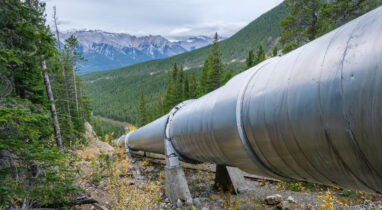The transition to a low-carbon economy presents an historic opportunity for Canada to generate lasting economic growth and good jobs for Canadians across this country. But too many firms are reluctant to make the big investments in decarbonization that are needed to drive that transition. What’s stopping them?
A new report released today by Clean Prosperity and the Canadian Climate Institute identifies important roadblocks to investment, and proposes measures that could kick Canada’s low-carbon transition into high gear.
The report draws on private-sector accounts of impediments to growth in Canada’s emerging low-carbon economy. In dozens of conversations, industry and investors said that uncertainty about Canada’s cornerstone climate policy — carbon pricing — is inhibiting investment, and urgently needs to be resolved in order to accelerate industrial decarbonization.
“Companies are concerned that a future federal government could freeze the carbon price or cancel it altogether,” said Clean Prosperity Executive Director and report co-author Michael Bernstein. “The policy risk is discouraging investments that depend on higher carbon prices to make them economic. Without greater policy certainty, the carbon price can’t live up to its full potential.”
The new report, Closing the Carbon-Pricing Certainty Gap, proposes that the federal government introduce an innovative mechanism called carbon contracts for difference that would act as an insurance policy on the carbon price — at no additional cost to Canadian taxpayers. It also proposes measures to reduce uncertainty about the future value of the carbon credits that many companies are counting on to make decarbonization projects economical.
“Companies are concerned that a future federal government could freeze the carbon price or cancel it altogether. The policy risk is discouraging investments that depend on higher carbon prices to make them economic.”
Clean Prosperity Executive Director and report co-author Michael Bernstein
Contracts for difference: how do they work?
A carbon contract for difference could be signed between the federal government and the proponent of a low-carbon project — like a green hydrogen plant, or a carbon capture installation attached to a cement factory or oil refinery.
If the carbon price fails to increase as planned to $170 per tonne in 2030, the firm gets a payout based on the difference between the actual and anticipated price in any year, in proportion to the firm’s proven emissions reductions.
This insurance policy on Canada’s carbon price gives companies the confidence to make big investments today — and at no cost to the government, assuming the carbon price rises as scheduled. Carbon contracts for difference could even be designed to generate public revenue in exchange for the de-risking value they provide to private companies.
Prevent oversupply of carbon credits
Concern about the trajectory of Canada’s carbon price is one half of the uncertainty problem that’s stalling low-carbon investment — the other half involves doubts about the future value of carbon credits, which are the currency of federal and provincial industrial carbon-pricing systems.
Most large emitters in Canada are regulated under these systems. They allow firms to earn carbon credits by reducing their emissions below set thresholds. Other emitters will buy those credits to satisfy their carbon-pricing obligations.
The price of carbon credits should be relatively predictable — it should closely track the rising federal price of carbon. But as more decarbonization projects come online, there’s a risk that the market could become oversupplied with credits, leading to a crash in credit prices. That risk is making companies reluctant to invest in decarbonization projects that depend on carbon-credit revenues in order to be profitable.
Closing the Carbon-Pricing Certainty Gap proposes that the federal government protect carbon-credit values by ensuring that industrial carbon-pricing systems are explicitly designed to prevent credit oversupply — consistent with the government’s own rules for the design of these systems.
This recommendation is especially urgent, because the government is now in the process of approving provincial carbon-pricing systems for the 2023-2027 period.
Act now to achieve targets
We have just over seven years to achieve Canada’s ambitious climate target, a 40% reduction in emissions below 2005 levels by 2030. If we’re to reach that goal, there’s no time to waste: we need massive investment in decarbonization now.
Carbon pricing is a powerfully effective tool to reduce emissions across Canada’s economy, but we need to reduce private-sector uncertainty about the durability of this cornerstone climate policy in order to unlock its full potential.
Closing the Carbon-Pricing Certainty Gap estimates that an effective carbon contracts for difference mechanism could accelerate up to 40 million tonnes of industrial emissions reductions. Making sure that industrial carbon-pricing systems support the demand for carbon credits will also incentivize big investments in decarbonization.
Canada is under intense pressure to meet our emissions targets and to transition to a low-carbon economy that can deliver national prosperity into the future. We’re also competing against other jurisdictions for talent and capital — especially the United States, which just announced hundreds of billions of dollars in subsidies for clean technology.
Upping Canada’s climate ambition, and our economic competitiveness, involves optimizing the climate policy tools we already have. We should start by closing the carbon-pricing certainty gap.
Key takeaways from the report
- Private-sector uncertainty about the federal carbon price is holding up urgently-needed investments in industrial decarbonization.
- Industry and investors are worried that a future federal government could freeze or cancel the carbon price.
- They’re also worried that a looming oversupply of carbon credits will make new decarbonization projects unprofitable.
- A proposed mechanism called carbon contracts for difference offers a guarantee on Canada’s carbon price, to give firms the confidence to make big investments today.
- Carbon contracts for difference could accelerate up to 40 million tonnes of industrial emissions reductions.
- Designing Canada’s industrial carbon-pricing systems to prevent an oversupply of carbon credits will incentivize decarbonization projects that rely on revenue from selling credits.




